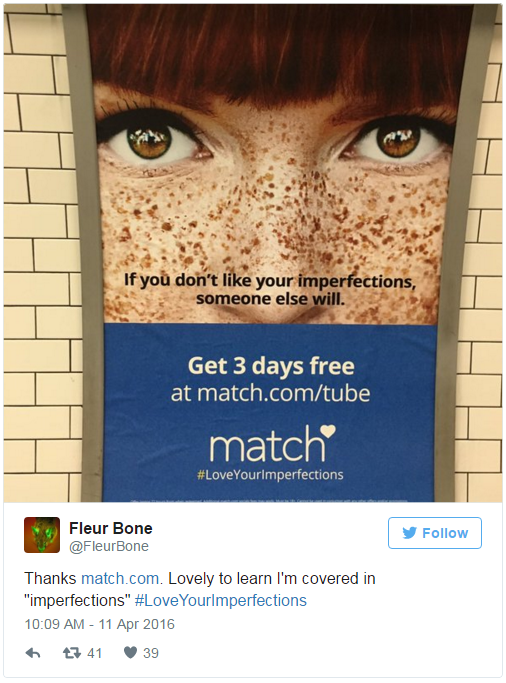Last year, according to Statista, the advertising spend in the UK was estimated at 19.6 billion pounds and is expected to exceed 20 billion pounds in 2016. This ranks the UK fourth among the world’s largest advertising markets.
Companies are spending millions to get their message and product out to world. Marketing departments and creative agencies are all trying to create that one campaign that gets everyone talking – think gorilla drumming to Phil Collins’ “In the air tonight” (Cadbury); cute talking meerkats (Compare the Market); or even a man cavorting in high heels and hot pants (MoneySuperMarket.com). However, sometimes ads go viral for all the wrong reasons. It is said there is no such thing as bad publicity, though you may disagree after reading some of these advertising fails:
1. Match.com
This month Match.com received an online backlash after this image of a billboard on London Underground was shared on Twitter. The ad, an extreme close up of a red-haired woman’s freckled nose and cheeks, featured the caption, “If you don’t like your imperfections, someone else will.” It has been labelled bullying on social media, and the Advertising Standards Authority have received a number of complaints.
Twitter users were quick to call out the ads, calling them “the lowest form of advertising” and accusing Match.com of “societal shaming.”
After offending a freckled population Match.com quickly removed the posters and issued an apology stating they ‘believe freckles are beautiful’. Damage already done?
2. Bic
In 2015 the South Africa division of Bic pulled this inconceivably sexist ad after receiving a hostile response on social media. The “empowering” ad implies that while women are great at looking good, it’s best to leave the thinking to the men. To add salt to the wound, it was published on National Women’s Day to honour the occasion.
Bic apologised, claiming the message was inspired by a post on a blog about women in business. However it wasn’t the first time Bic has been accused of being sexist. In 2012 a line of “for her” pens was launched with Bic claiming they were, “designed to fit comfortably in a woman’s hand.” Possibly time for a new pen?
3. Starbucks
The design and marketing team were unlikely prepared for such controversy when they launched their simplistic holiday season design in 2015. Every year the release of the red holiday cup, with a variety of designs is met with much anticipation and according to Starbucks, “Within the first 48 hours of red Starbucks cups launching last year (2014), a photo of a Starbucks holiday cup was shared on Instagram every 14 seconds.” Wow!
Last year they went with a minimalist, fresh new design; a solid red cup, with the green Starbucks logo – a safe bet right? Or not. Customers were left upset because they expected a more traditional Christmas design and Starbucks was accused of being over politically correct and ruining Christmas. Some even accused the company of hating Jesus. Although typically the cup has never featured overly religious symbols but focusses more on snowflakes and candy cane imagery.
Did this fiasco damage the brand? It effectively turned millions of people into marketers, with the topic trending globally on Facebook and Twitter. Starbucks stock prices weren’t overly affected and the protesters still bought their Christmas Cookie Lattes. What will 2016 bring?
4. McDonald’s

In 2012, McDonald’s launched a Twitter campaign using the hashtag #McDStories hoping to encourage engagement and consumer interaction. The goal: to inspire people to share heart-warming stories about the good times they have at McDonald’s.
Such a campaign is risky when, as hugely popular as McDoanld’s is, it does come with its fair share of haters. It wasn’t long before this became a #bashtag, with people worldwide hijacking the hashtag to share their negative experiences and horror stories from visits to the chain. Even ex ex-employees got involved.
#McDStories too many -_- I work at that wretched place
— Meg (@heylookitsmegz) January 18, 2012
#McDStories some woman saw a mouse and started running around screaming. the people behind the counter acted like it happened all the time.
— Nora Panahi (@heyychief) January 18, 2012
one time I got a chicken sandwich that wasn’t cooked and I didn’t know till I had eaten half of it. never got one of those again #McDStories
— Sydney Carlino (@sydsydney) January 18, 2012
Even though the campaign was pulled after just two hours the hashtag is still used by many to this day.
I was given a double cheese burger with ketchup only. It’s incredible that they gave me exactly what I didn’t want. #McDStories
— Turner (@TurnerDowhan) April 19, 2016
This fail highlights that crowd-sourced campaigns are impossible for a company to control, let alone stop. However it is worth noting on that infamous day there were 72,788 mentions of McDonald’s overall, and only 2% of those were attributed to #McDStories. Share prices have continued to rise and the brand remains largely unaffected.
4. Heinz
An unsuspecting consumer got quite the shock when they scanned the QR code on their bottle of Ketchup. The man scanned the code to enter Heinz’s online competition in Germany, but the Heinz QR code and website had expired – and an X-rated site had taken its place instead.
The campaign had ended in 2014 and, considering bottles of ketchup can remain in household for some time, Heinz surprisingly didn’t see a need to renew the QR code and attached domain when it expired. Heinz offered an apology to their customer and FunDorado, the porn site that acquired the QR code and domain, offered the customer a year’s free access to their website! Steps have since been taken to avoid a repeat of the situation.
Damage done?
It’s fair to say that none of these brands were hugely damaged, if at all, by their unfortunate marketing attempts. In an age where news and information is shared immediately, and on a large scale, having thousands of people mentioning your brand name, even for the wrong reasons, can have its benefits. With the fast pace that information is being consumed, these doomed marketing campaigns quickly become yesterday’s news.




